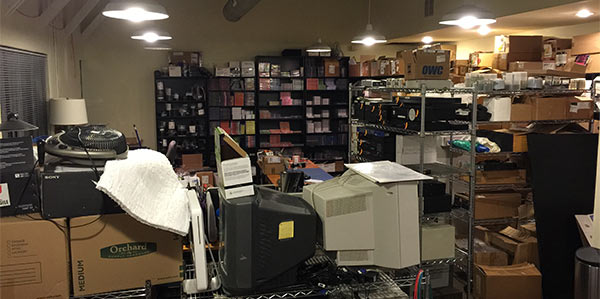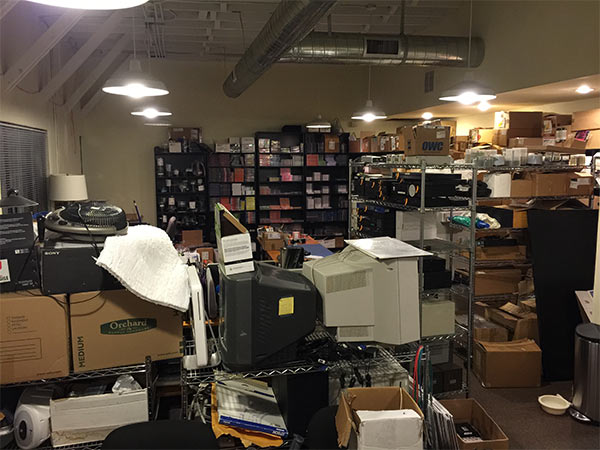New Studios At AIX
I’m staring down a very daunting task. In the next week or so, I have to clear out of the room that holds all of my records, my fulfillment area, my wife’s order desk area, and my own office corner. It took me over a month to get this room all put together when I moved out of the rear of the building and I can’t imagine how I’m going to vacate the space in such a short time. But it has to be done so that I can turn this 900 square feet into three new studios…for a producer/engineer and a couple of his associates. It seems my fortunes are largely tied to the number of studio spaces I can make available in the building that my wife and I purchased 9 years ago.
A large number of younger audio engineers, musicians, producers, DJs, and composers are seeking homes for their little enterprises and this building has become a first home for their studios and businesses. I walked past one of the rooms (my former office in the rear of the building) earlier today and heard one of my new tenants holding a singing lesson. He and his student were singing arpeggios from each chromatic pitch he played on his sampled piano. There are all kinds of musical activities happening in the space. I’m thrilled.
Not to worry, I’ll still have the main studio in the rear of the building and I’ll be moving my desk and several computers to the small office just outside the current space. I’m creeping closer to the day when I spend more time at the beach running with Charlie than I do here at the studio. But that day hasn’t come yet. I’m making good progress on the book (more on that in a future post) and anxious to make some new recordings next year. I said I’m getting closer but not that close.
Figure 1 – The space in the front of my building that will be emptied to make room for three new studios.
But right now I’ve got to figure out where to store a lot of boxes, old equipment, and misc stuff. Undoubtedly, I’ll be offering some stuff on eBay (I’ve got a really great DAC from PS Audio…it’s the Ultralink form about 15 years ago. It still sound great but doesn’t do high-res) and taking whole bunch of aging hard drives to the local tech recycling place. The rest will wind up upstairs or in a storage space.
There will be three new custom studios built in this space over the next couple of months. The plan includes a 5.1 surround mix room complete with video projection; a live room large enough for a moderate sized drum kit, and a smaller “in-the-box” production room. Each room will have double soundproof doors, isolated HVAC, and non-parallel walls for optimum sound. I realize this isn’t necessarily the kind of project that any of you would contemplate building at home, but it might interest your musician offspring. So I’m going to be sharing the planning, design, construction, and equipping of these rooms over the next 8 weeks. The new tenants plan to move in on the first of February. There’s no time to waste.
Stay tuned.



Offer the new tenants a break on the first months rent to come in and help you schlep all that stuff around. Sooner you get out the sooner they get in. LOL
Good luck with everything.
IE, The loudness wars from yesterday.
I downloaded the 24/96 HDTracks file of Jeff Lynne’s ELO – Alone In The Universe.
It measured a DR 7 with a min of 5 and a max of 8
Things are getting worse not better, from a higher respected producer like Lynne of all people.
Do you plan to use PMC loudspeakers in any of the planned studio rooms?
I’m supplying the room and the new tenants will equip them. I like PMC speakers…there is a surround set in the middle studio. But they’re not my favorite.
It will be very interesting to me to follow your building progress as I’m starting to set up a 5.1 room at home.
Can’t wait for your book!
“The plan includes a 5.1 surround mix room”
Circle the wagons boys, there’s a whole lot of them going to attack from just over that hill in a few minutes. What do you mean we only have five wagons?
Five speakers, usually point sources, aimed directly at you. That’s what they call “surround sound.” It is of course a terrible misnomer, a joke compared to the real surround sound of a concert hall whose sound envelops you. How much reflected sound comes from any one direction in a concert hall? So little you can’t hear it even with your ear up against the walls. How much comes to your ears in aggregate? Over 90% of what you hear, in fact sometimes almost 100%. So surround sound is a fraud just like high resolution is. It conjures up notions that have no real meaning.
Mark, how are you going to isolate the sound from one studio to the next? What architectural methods will you use so that two adjacent studios can be used at the same time without interfering with each other. What specifications for attenuation as a function of frequency will your architect design to? Are there AIA criteria like there are for concert halls? I’d guess there must be.
The use of point source speakers as in a stereo of 5.1 or 7.1 of 22.4 array doesn’t equate to 2,5,7, or 22 individual sources, as I’m sure you know. The use of speakers with material panned between them has been widely used since the introduction of stereo. It’s true that a concert hall is a different experience (in fact much less immersive IMHO) than an immersive 5.1 surround music mix but surround sound is very real, very compelling, and when done well is a huge enhancement over traditional stereo.
The design of the new rooms and the details of the isolation methods etc will be discussed as we go through the process. As we’ve done number of studios in the building (now 6 and counting), we’ll be doing the design and work without an architect. There are transmission specs for noise and leakage but I don’t know them…I just know how to minimize leakage.
So if I understand you correctly, a surround sound system is more immersive and therefore preferable (?) to hearing live music at Boston Symphony Hall or an organ recital in a cathedral?
A supermarket or department store can have a 100.0 sound system or larger but the sound always appears to be coming from directly overhead.
With direct firing point source systems you can invariably detect the source of what are supposedly the surround channels. This was the first and most obvious flaw I discovered immediately when I first heard quadraphonic sound. I find it unacceptable. Wave Field Synthesis gets around this problem by having a continuous line array of speakers placed edge to edge surrounding the listener in 360 degrees but for practical reasons, only in the horizontal plane which IMO is a shortcoming. In some installations this means many hundreds of speakers.
Personally, I prefer listening to my recordings of a classical symphony in 5.1 aggressive “stage” mixes more than sitting in the audience at Disney Hall. That’s my personal preference…it is more immersive and more engaging for a number of reasons. Phantom center and spatial panning is real and works. You’re welcome to like what you like…but things are better than you describe.
I think the key words are “surround done well” which as a musician means an immersive experience from being among the band members rather than among the distractions of a live audience. There’s no shortcuts around hands on experience of learning what microphones work best where or even having experienced being on stage with other musicians versus being centered in a soundstage full of chairs squeaking, the occasional ill-mannered audience members who can’t seem to be quiet when the music is being played, lastly and unfortunately, there’s not enough recording professionals dedicating the time, continuing education, & costs to make more well made 5.1 or higher recordings. The tail is wagging the dog to death because of the lack of surround titles available in even good quality resolution let alone HRA. I’d certainly purchase non HRA BD’s that were done properly of material i already own. I’m a record labels dream! I may even be part of the problem, but I won’t fall for the “digitally remastered” moniker of BS without regard to provenance. Thanks for the ever continuing education Dr Waldrep!
Sadly, there’s no real market either. Thanks.
“With direct firing point source systems you can invariably detect the source of what are supposedly the surround channels.”
Wrong. If you can “invariably detect the source” of the surround channels, then you haven’t calibrated the speaker distances correctly (or at all) or you’re sitting too close to the rear speakers. I’m speaking of discrete multichannel recordings, of course. When a system is set up properly, the ears perceive a unified soundfield. True surround recordings, such as those Mark or 2L, for example, create are different in that they place musicians around the listener, so distance correction isn’t as important. This is a matter of taste — some people like this perspective, some don’t.
You’re right Mark, there’s no real viable market that is interested in HRA, but I believe it’s a matter of educating people. Young people specifically. They’ve lived their entire lives in a digital age, but unfortunately they’ve listened to crappy headphones (from $5-$400) meaning junk to the high dollar (a style statement not one of quality) /low fidelity. Crappy music in MP3 format with no sense of what dynamic range is, or why it’s so important. Most aren’t aware of how a musician uses dynamic range to punctuate the ranges of emotions in the passages of their works. For that matter, it’s probably unknown to today’s youth that there’s actually a lot more instruments in the music they’ve been listening to. They don’t need to know, the droning mindlessness of the EDM music I’ve heard of late,explaining why kids are snorting drain-o or whatever it is this week. I’ve shown some friends kids some great equipment at my favorite hifi store and most have been stunned ( a few with their own material) and enthusiastic about hearing real music for the first time in their lives. We are a small subset of a small subset, but if the manufacturers and the labels are pushing their snake oil, we must have a chance for some honesty and accountability from the aforementioned. It’s a idealistic thought, but I think it holds water. L
I agree that people…especially young people…can be convinced about better sound. But most are unwilling or unable to afford the equipment necessary to realize the improvement. They’d rather stay portable. Good enough is good enough.